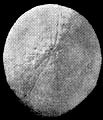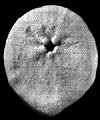The Echinoid Directory
Hemicara Schlüter, 1902, p. 332
| Diagnostic Features |
|
|---|---|
| Distribution | Upper Cretaceous (Cenomanian) of Poland and Germany. |
| Name gender | neuter |
| Type |
|
| Species Included |
|
| Classification and/or Status | Irregularia; Neognathostomata; 'catopygids'. |
| Remarks |
|




